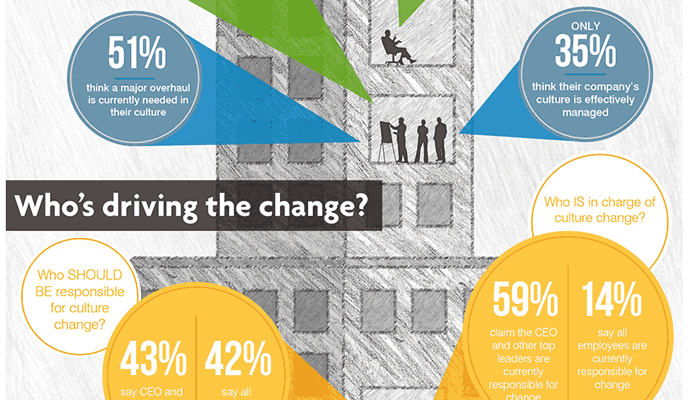Culture: Transformation’s invisible enabler
Successful transformation often requires organizational culture change to make the improvements stick. Leadership teams can increase their odds by focusing on three measures.
Here’s how a transformation effort often happens—and derails—at many organizations. The CEO and executive team decide that they want to make a big change, whether it’s improving quality; implementing digital transformation; addressing environmental, social, and governance issues; or any other objective. Recognizing that this means changing how people work, the senior team issues some top-down messages, littered with vague adjectives and abstract nouns; the company “will be agile in everything we do,” perhaps. In theory, it all sounds great—after all, who can argue with agility? But fast-forward a few months later, and nothing much has changed (other than a notable rise in employees’ skepticism). Oftentimes, even the transformation itself has stalled. Why? Because employees heard a series of words that had no meaning in their day-to-day reality.
The scale of change that companies are facing requires them to be resilient and adaptable. Engaging your people in a transformation journey has never been more important. To do that successfully, you need culture—the invisible enabler that allows a broad set of changes to take root organically—on your side. In our work with multinational companies, particularly in regulated sectors, we’ve identified three important lessons for organizations seeking to leverage culture as part of a transformation journey.
Lesson 1: Connect culture to the business “so what?”
Culture change cannot be achieved in isolation, and it should never be an afterthought to operational transformation. Culture must be rooted in business context and rationale—an integral element of the continuous journey, from transformation assessment to performance measures.
We’ve worked recently with a multinational pharma company that was embarking on a large-scale transformation to optimize business processes and systems. The leadership team knew that the associated culture change would be critical. What they didn’t know was whether the company’s current culture was getting in the way of where they wanted to be. So we conducted a culture assessment to understand the existing pain points.
This uncovered cultural issues that were affecting operations. A lack of cross-functional collaboration between teams, for example, was delaying the start of clinical trials, which impacted the product pipeline and speed to market. A part of the solution was to focus on the way these teams interacted on a daily basis. We coached and worked with the teams to define individual and collective behaviors linked to business outcomes and key performance indicators (KPIs).
To connect to the business “so what?” culture change has to be rooted in measurement. Linking behavioral indicators to business-focused KPIs will give you timely and actionable information. Imagine that you want to lose weight—say, ten pounds over six months. How do you track your progress? You could weigh yourself once a month, but if you find you’re not on target, your opportunity to change that result is gone. A better leading indicator of whether you will hit your target is your ongoing behavior. If you set a target of going to the gym four times a week but miss this key behavioral indicator, you’re aware ahead of time that you’re not on track to meet your goal.
Lesson 2: Translate the change down to specific frontline team behaviors
Business outcomes clarify the macro context for culture change, but employees also need to understand the micro aspect—what needs to change in their daily work and how they function as a team. To keep from overloading employees, this should be limited to a critical few target behaviors, which will allow for measurable results.
Let’s take as another example a pharma generics company that was seeing recurring deviations across its manufacturing line, leading to delivery delays for patients. The catchall of “human error” was deemed the culprit. The solution was to encourage root-cause problem-solving, but what did that mean for leaders and employees in practice? We focused on two target behaviors:
• Leaders were to commit to “actively working with teams to free up capacity for problem-solving, and respect that time.”
• Team members were to commit to “proactively raising reoccurring issues and bringing solutions to the table for team-based problem-solving.”
These behaviors were reinforced through supporting mechanisms including regular leader gemba walks (a Japanese term for when leaders visit worksites firsthand), capability-building in problem-solving techniques, and visible rewards for and celebrations of success. As a result, the site is seeing a reduction in repeat manufacturing deviations.
Engaging your people in a transformation journey has never been more important. You need culture—the invisible enabler that allows a broad set of changes to take root organically—on your side.
We’ve worked with one leadership team whose business was growing at an exponential rate. But as a team, they struggled to make and stick with decisions, often revisiting them after the fact. “We just seem to talk ourselves around in circles,” as one of them put it. What could they do to make themselves more agile? Together, we came up with some key behaviors, including “follow the decisions in the meetings I missed” (leaders still need to commit to implementing decisions made without them) and “select something to de-prioritize for every new priority.” Now that the team has agreed on team behaviors, they are putting in place ways to reinforce their commitments. For instance, they agreed to stop a meeting when a behavior is not displayed, explicitly call out when they need to make an exception to the behavior and why, and conduct a three-month effectiveness check on whether decision-making is improving.
Lesson 3: Create a plan—but expect to adapt it
As with any change effort, it’s crucial to have a plan in place at the outset. But you also need to expect that the plan will change. Measures that work in one business unit or geographic market may not work at all in another, so respond to what’s in front of you rather than what you expect to see. Focus on incremental progress, rather than trying to force major changes in a hurry. And consistently monitor, learn, and celebrate results.
This principle is common across many companies and among the leaders working to influence culture. Recently, we paused our culture work for a multinational company—part of a large-scale transformation program—when it became clear that one business unit was a source of significant risk. Rather than carry on as planned, we took a step back and focused on this business, carefully listening to its team members so we could be clear on what they needed and what we could do to help. (In this case, it meant creating a high-performing leadership team before doing anything else.)
Business leaders’ biggest misperception about culture work is that it’s too ethereal and fluffy to make a difference. Based on our experience, culture is a key means of creating sustainable transformation, along with foundational elements like broad-based communication, employee engagement, and leadership alignment. The challenge is linking culture work to practical, business-relevant changes that directly affect the behaviors of frontline employees. By applying the three lessons discussed above, companies can create a partnership in which culture practitioners and business leaders learn from each other—and generate lasting impact.
Author profiles:
- Luna Corbetta is a principal with PwC US in the workforce transformation practice. Based in Tampa, Fla., she specializes in strategy and transformation, and is passionate about connecting people and organizations to their core purpose.
- Margo Stokum is a director with PwC US in the workforce transformation practice. Based in Mountain View, Calif., she specializes in culture and talent strategy for organizations going through large-scale transformations or preparing for the future of work.





